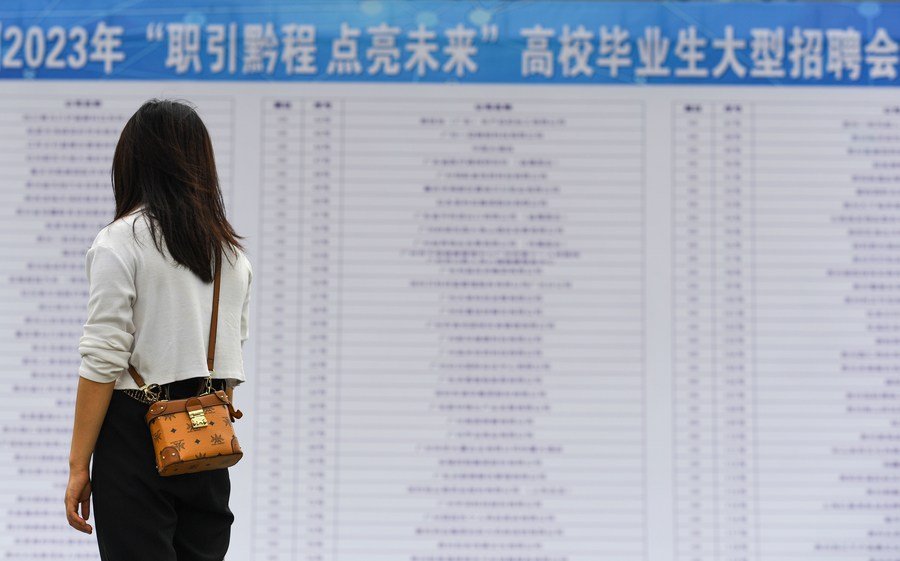
A college graduate reads recruitment information at a job fair in Qiandongnan Miao and Dong Autonomous Prefecture, southwest China's Guizhou Province, June 30, 2023. /Xinhua
A college graduate reads recruitment information at a job fair in Qiandongnan Miao and Dong Autonomous Prefecture, southwest China's Guizhou Province, June 30, 2023. /Xinhua
In recent years, there has been growing concerns regarding the future of China's "demographic dividend" as the country's demographic landscape shifts. These are primarily driven by an aging population and low birth rate, raising questions about the potential erosion of this once robust economic advantage.
However, a closer examination of China's demographic landscape reveals a more nuanced picture. Despite facing demographic challenges, China possesses several factors that could help sustain its "demographic dividend" in the coming years.
"Demographic dividend" refers to a period of rapid economic growth resulting from a favorable demographic structure. This advantage arises when a large working-age population surpasses the number of dependents, resulting in enhanced productivity, increased savings, and greater investment prospects.
"China's rapid economic growth in recent decades can be partially attributed to this phenomenon," said Liu Yaqiu, a researcher at National Institute of Social Development at the Chinese Academy of Social Sciences (CASS).
"However, its economic growth is not solely determined by population size. It also involves factors such as the country's rapid and stable infrastructure development, and the overall improvement of the population's education level," Liu told CGTN.
From demographic dividend to talent dividend
In recent decades, university enrollment in China has surged, with the gross higher education enrollment rate reaching nearly 60 percent last year, as reported by the Ministry of Education.
China has established the world's largest higher education system with 240 million individuals having received higher education. In terms of innovation and entrepreneurship education, colleges and universities across China have developed over 30,000 specialized courses and employed 174,000 teachers with professional backgrounds.
"China reduced its birth rate rapidly, but it has smaller number of children to educate, and so it is able essentially to educate them more and more to a higher and higher level … to improve the level of human capital. That is a fundamental strength which I think that China has going forward," said Tim Dyson, emeritus professor of population studies at the London School of Economics and Political Science.

School pupils watch two robots combating at an artificial intelligence education centre in Handan, Hebei province, China, May 25, 2023. /AFP
School pupils watch two robots combating at an artificial intelligence education centre in Handan, Hebei province, China, May 25, 2023. /AFP
Despite a decline in the overall working-age population, China retains a substantial labor force, particularly noteworthy for its abundance of skilled workers. This advantage positions China favorably in the global market.
China has nearly 900 million working-age individuals, who have received an average of 10.9 years of education, according to the Chinese Foreign Ministry. For those who are just entering the workforce, their average length of education has increased to nearly 14 years.
Other factors
China's working-age population started declining in 2013. However, when considering demographic indicators such as the proportion of the working-age population and its dependency ratio, China's demographic dividend is still intact and could last for another 10 years, noted Chen Wei, a professor at the Center for Population and Development Studies, Renmin University of China.
Over the next decade, the size of the China's population will continue to support its robust industrial system and create ample space for economic structural transformation. China's growing and healthy aging population and education conditions will also increase the consumption of goods and services, according to Chen.
Apart from the improving population quality, China's ongoing urbanization drive has led to substantial internal migration, as millions of rural residents seek better job prospects in cities.
This process not only stimulates economic growth but also addresses labor market imbalances by redistributing the workforce to industries and regions where it is most needed.
China still has ample room for further urbanization, which will help facilitate human capital mobilization and social mobility, not only just economic growth, according to Zheng Zhenzhen, professor at the Institute of Population and Labor Economics at CASS.
"With further modernization of the agricultural sector, a larger proportion of the labor force can be released from farming and better utilized in other sectors," she wrote in an article published on CGTN earlier.
Further improvements in employment, especially youth employment, are necessary to utilize human capital more effectively, and pension reform and postponement of retirement is important to enable older workers to play a role and to contribute to development, noted Zheng.